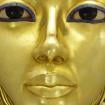
Striking at the Heart of the Pharaoh: Social Injustice and Deception in the Place of Truth – Part I
A couple of years before he celebrated his jubilee, Ramesses III was beset by internal problems. A great king who had combated vicious enemies from all corners and was deified by his subjects for his decisiveness; he was cast into a cauldron of unpopularity for a brief while, when a seemingly innocuous protest about delayed wages by elite artisans from Deir el-Medina turned into a commentary on corruption and social injustice which led to the world’s first recorded strike.

At a time when several civilizations in the region were biting the dust one after another, the astute leadership of Ramesses III ensured a stupendous militaristic victory over Egypt’s enemies, notably the Sea Peoples. In this exquisitely painted relief the king is shown making offerings to the gods in the sanctuary of the Temple of Khonsu at Karnak. (CC BY-SA 3.0)
A King Like None Other
Over the course of two decades on the throne, Pharaoh Ramesses III had achieved military victories that would have been the envy of even his formidable predecessors. When every kingdom in the Near East and Mediterranean was decimated by the treacherous reign of terror unleashed by a coalition of forces known as the Sea Peoples, under the powerful leadership of Ramesses III the Egyptians alone had successfully repelled the attack on their soil. Not just the Sea Peoples, but the Libyans and a rag-tag assemblage of tribes too tasted the wrath of the pharaoh during this period.
In what was an unwritten law in ancient Egypt, monarchs celebrated their triumph in battle by erecting grandiose monuments in honor of the gods. These war memorials, that were filled from top to bottom with inscriptions and depictions of battle scenes showing the pharaoh’s gallantry – much like a bulletin board – also doubled up as effective propaganda machines. It was now the turn of Ramesses III to follow suit and commemorate his improbable military victories. But instead of embarking on commissioning a new monument, Ramesses III converted his pre-existing ‘Mansion of Millions of Years’, which was a palace-cum-mortuary temple modeled on the lines of the Ramesseum built by his outstanding predecessor Ramesses the Great. On the entire northern wall of this temple a vast tableau depicting the land and sea battles against the Sea Peoples was carved for all the world to see.
Like this Preview and want to read on? You can! JOIN US THERE ( with easy, instant access ) and see what you’re missing!! All Premium articles are available in full, with immediate access.
For the price of a cup of coffee, you get this and all the other great benefits at Ancient Origins Premium. And - each time you support AO Premium, you support independent thought and writing.
More upcoming in Part II, an Ancient Origins Premium series by independent researcher and playwright Anand Balaji, author of Sands of Amarna: End of Akhenaten.
[The author thanks Heidi Kontkanen, Howard Middleton-Jones, Merja Attia and Leena Pekkalainen for granting permission to use their photographs. The public archives of the Metropolitan Museum of Art can be accessed here.]
Top Image: The Ramesseum witnessed high drama during the workers' protest against the third king to bear the name, Ramesses. Pictured here are headless Osiride statues of Ramesses II. (CC BY-SA 2.0)
By Anand Balaji















